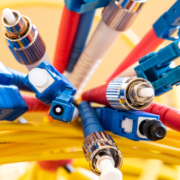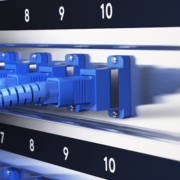How Do Fibre Optic Cables Work? (FAQ’s)
How Do Fibre optic cables transmit data?
How do fibre optic cables work? Fibre optic cables can carry data between locations without the need for an electric signal. This is because of the properties of light, which are based on how it acts when in its pure form. It can be manipulated by passing it through specific materials. For instance, when passed through a prism, which is transparent with a longish, thin shape, it splits into colours and forms a rainbow. The exact position of the colours is representative of the wavelengths present in the original light. Fibre optic cables do not need electricity because they can send messages using beams of laser light instead. The messages consist of 0 and 1 and every combination between these two (known as bits).
What is Fibre optic single mode?
To send messages using laser light, a laser is sent from one place and the messages are encoded onto the beam of light. Furthermore, fibre optic single mode uses pulses of laser light to send messages between locations in fibre optic cables. As only one type of light can be used for this it is known as single mode.
What is Fibre optic multi-mode?
Multi-mode fibre does not use laser light. Instead, it uses a range of wavelengths from infrared to ultraviolet which are cheaper to produce. This method is known as multiplexing which can be used together with the single mode system.
How are bits of data received by a computer?
On reaching its destination, the laser light is collected and sent through a special piece of equipment called an optical detector. The detector reads the pulses of light and transforms them into an electrical signal, which is then decoded into the original message.
What are the advantages of fibre optic cables?
The main benefit of using fibre optics is that it can carry data over long distances without the need for electricity. As a result, this saves on energy costs and reduces carbon emissions. Fibre optics are also more secure because information cannot be intercepted by third parties.
How are Fibre optic cables made?
Fibre optics can be created in several different ways. Firstly, it is manufactured on the molecular level by growing crystals of semi-conducting materials such as silicon dioxide (SiO2). This material has small holes which act like fibre optics, carrying light over short distances. Then, after purification and cleaning, it can be drawn out into fine strands which are used to make the cables. This method provides the best quality fibre optics but needs equipment that is much more expensive than other options.
How can Fibre optic cables fail?
Fibre optics fail because of the different effects on them, such as temperature, pressure, and dirt. They are also more fragile than other cables because there is no metal casing protecting the cables inside. This means that they can be easily damaged if not handled carefully.
How can Fibre optic cables be used?
Fibre optics are used in many different applications including telecommunications (telephones) and computer networks (internet). They are used in these systems because they can carry information for very long distances without the need of an electric signal.
What is LASER?
A laser (Light Amplification by Stimulated Emission of Radiation) emits a beam of light which can be made highly concentrated and filtered to a specific colour. It works by stimulating atoms in a specific material in order to emit photons (which are packets of light), in turn stimulating other atoms and so on. Lasers use stimulated emission to produce coherent radiation, which is then focused into a beam by an optical system.
What is fibre cladding?
The cladding is a layer of material around the inner core. The cladding has a lower refractive index than the core, allowing light to escape from the core into the cladding. This reduces loss due to reflection back into the fibre.
Do fibre optic cables offer a higher level of security?
Fibre optic cables, due to their structure and transmission of data, offer a higher level of security. This is because a fibre optic cable consists of a solid core with no openings. It cannot be tapped without the risk of severing it completely.
What is Optical Network?
An optical network is a telecommunications network which uses fibre-optic cables to carry information. It can transmit data at high speeds over long distances using lasers, which are used to convert the data into light.
For PON (Passive Optical Network) click here.
What are the benefits of optical fibre?
The main benefit of optical fibre is that it is made from materials which do not conduct electricity. This means it cannot be interfered with by electric currents which may be present in other cables. It also means that any data can be transmitted without suffering interference, because there is nothing to interfere with the signal. Optical fibres are also much thinner than copper wires so they can carry more data in one cable. This enables faster speeds and more efficient networks.





